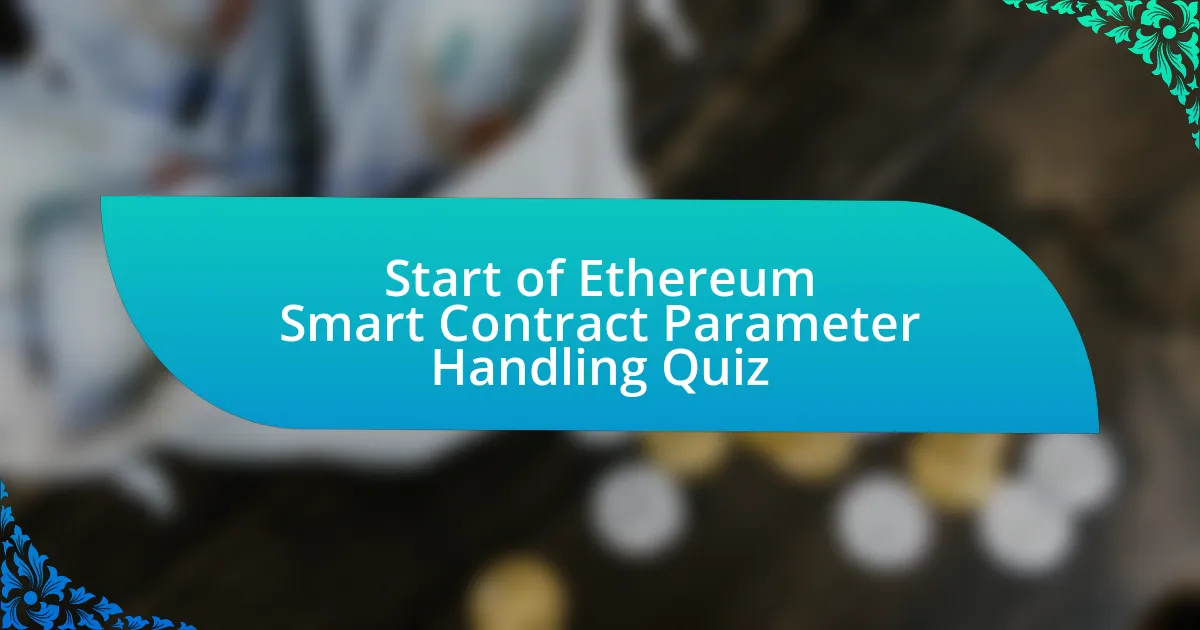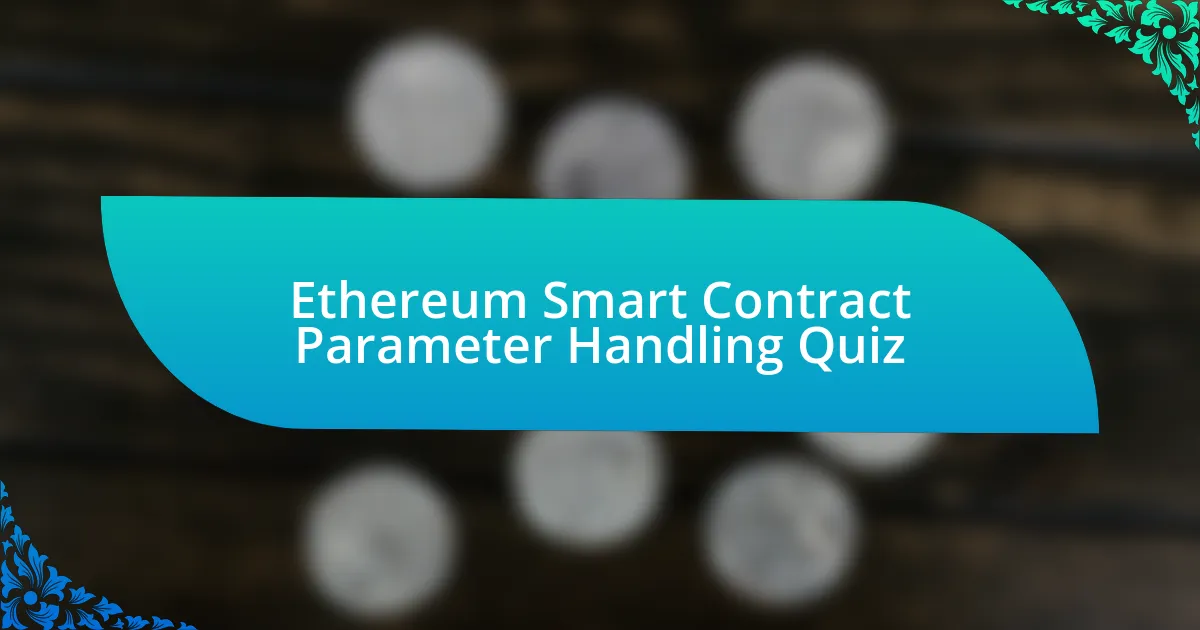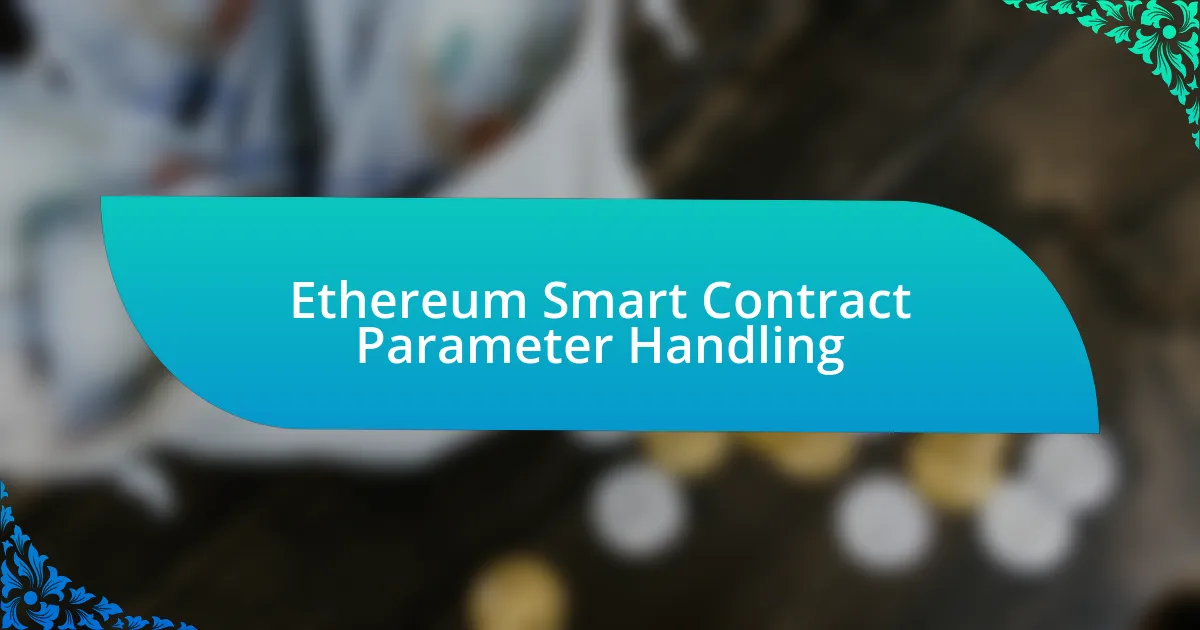
Start of Ethereum Smart Contract Parameter Handling Quiz
1. What is the function of the `from` parameter in an Ethereum transaction?
- The amount of Ether being transferred.
- The address the transaction is sent to.
- The gas limit for the transaction execution.
- The address the transaction is sent from.
2. What does the `to` parameter specify in Ethereum transaction data?
- The amount of Ether being sent in the transaction.
- The address the transaction is directed to (optional when creating a new contract).
- The gas limit for the transaction execution.
- The nonce number for the transaction order.
3. How does the `value` parameter impact transactions on Ethereum?
- Integer of the value sent with this transaction (optional).
- Specifies the gas price for the transaction.
- Indicates the sender`s address for the transaction.
- Defines limits on transaction amounts.
4. What role does the `gas` field play in Ethereum transactions?
- Integer of the gas provided for the transaction execution (optional, default: 90000).
- Integer representing the sender`s address in the transaction.
- Integer of the total data sent along with the transaction.
- Integer of the amount of Ether sent with the transaction.
5. What does the `gasPrice` parameter indicate in an Ethereum transaction?
- Integer of the total value being sent with the transaction.
- Integer of the amount (in gwei) you’re willing to pay per gas for the transaction to execute (optional, default: To-Be-Determined).
- Integer representing the total number of transactions sent.
- Integer of the maximum gas units you are willing to use.
6. How is the `data` field utilized in Ethereum transaction payloads?
- For contract deployments and interactions.
- To log contract executions only.
- To store user account balances.
- To track transaction fees only.
7. What is the significance of the `nonce` field in a transaction on Ethereum?
- Integer for the total amount of Ether sent in the transaction.
- Integer representing the gas limit for the transaction.
- Address of the contract that executes the transaction.
- Integer of a nonce, for maintaining transaction order.
8. How do you derive a function selector for Ethereum smart contracts?
- By appending the function name to the contract address.
- By summing the argument types of the function.
- By taking the first 4 bytes of the hash of a function signature.
- By selecting random bytes from the function’s bytecode.
9. What variable types are available in Solidity programming?
- string, address, uint256
- char, float, complex
- int, byte, decimal
- list, dict, tuple
10. What syntax is used to declare a new variable in a Solidity contract?
- set myVariable to uint256
- declare myVariable as uint
- var myVariable int
- uint256 public myVariable
11. Why is the SPDX-License-Identifier important in Solidity contracts?
- To specify the license under which the contract is released.
- To define the contract`s owner and address.
- To manage access control for the contract functions.
- To declare the contract`s constructor parameters.
12. What is the correct way to define a constructor in Solidity?
- By using the `constructor` keyword followed by parameters in parentheses, e.g., `constructor(bytes32 name_)`.
- By using the `init` keyword followed by the contract name.
- By defining a function with the same name as the contract.
- By using the `setup` keyword and no parameters.
13. How do `private` and `internal` access modifiers differ in Solidity state variables?
- `private` variables are only accessible within the contract, while `internal` variables are accessible in derived contracts.
- `internal` variables are only visible in external transactions.
- Both `private` and `internal` variables can be accessed globally.
- `private` variables can be accessed by any contract.
14. How can modifiers be applied to functions in a Solidity contract?
- By calling the function multiple times in a loop.
- By commenting on the code to explain the function.
- By defining a modifier and using it before the function definition.
- By declaring functions as public in the contract.
15. What is the difference between `constant` and `immutable` in Solidity?
- A constant variable can change after deployment.
- Both are assigned at construction time only.
- Immutable variables are fixed at compile-time.
- A constant variable must be fixed at compile-time, while an immutable variable can be assigned at construction time.
16. In what way does the `require` statement function in Solidity contracts?
- To declare a state variable in a contract.
- To log events during contract execution.
- To send Ether from one address to another.
- To enforce conditions and revert transactions if they fail.
17. What does the `view` keyword signify in a Solidity function definition?
- To indicate that a function is private and cannot be called externally.
- To declare functions that do not modify the state of the contract and can be called externally.
- To declare asynchronous functions that run in parallel.
- To signify that a function will always return a value.
18. What method is used to modify a state variable in a Solidity contract?
- By using a function that modifies the state variable.
- By utilizing the `send` function only.
- By updating directly in the constructor.
- By calling the contract`s address.
19. What does `msg.sender` refer to in a Solidity contract?
- The address of the caller of the current function.
- The address of the contract being executed.
- The address of the last miner who confirmed the block.
- The maximum gas limit for the transaction.
20. How is a contract`s state initialized when deploying in Solidity?
- By using the constructor and assigning values to state variables.
- By defining global variables before the contract.
- By using a separate function after the contract deployment.
- By using only default values without assignments.
21. What does the `payable` keyword enable in Solidity functions?
- To declare a contract as non-upgradable.
- To indicate that a function can receive Ether.
- To specify a gas limit for the transaction.
- To define that a function is only for internal use.
22. How do you define a mapping structure in Solidity?
23. What is the purpose of the `pragma solidity` line in Solidity code?
- To specify the version of the Solidity compiler to use.
- To initialize state variables in the contract.
- To define global variables for the contract.
- To declare the contract`s name and properties.
24. What tools are commonly used to deploy Ethereum smart contracts?
- GitHub
- Truffle
- Node.js
- Express.js
25. How does `web3.eth.Contract` facilitate Ethereum interactions?
- To connect Ethereum to traditional databases.
- To store user passwords securely.
- To facilitate contract interactions on Ethereum.
- To manage cryptocurrency exchanges efficiently.
26. What are the characteristics of a public function compared to a private function in Solidity?
- Public functions are only visible to the contract owner.
- Private functions can be accessed from anywhere.
- Internal functions can only be accessed by external contracts.
- Public functions can be accessed from anywhere.
27. How can errors be managed within a Solidity smart contract?
- By integrating external libraries for automatic error handling.
- By utilizing the `constant` keyword for variable declarations.
- By adding multiple constructors in the contract.
- By using the `require` statement to enforce conditions and throw exceptions.
28. What role does the `transient` keyword play in Solidity?
- To declare variables that do not persist between function calls.
- To indicate a function is computable off-chain.
- To specify contract deployment parameters.
- To declare functions that can modify blockchain state.
29. What practices can minimize gas usage in a Solidity smart contract?
- By increasing the complexity of the code and adding more features.
- By using excessive gas prices and inefficient algorithms.
- By minimizing the number of operations and using efficient data structures.
- By ignoring optimizations and focusing on ease of use.
30. What does the `block.timestamp` variable provide in Solidity?
- The gas price for the transaction.
- The current block epoch timestamp.
- The sender`s address of the transaction.
- The value sent with the transaction.



